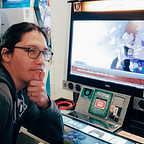How to play neutral, for new fighting game players
“Neutral” in fighting games is the state where both players are capable of moving and hitting. Since both players are capable of using their full moveset in neutral, it’s more difficult to predict the opponent’s next move than it would be in a more restricted situation, so it’s easy for less-experienced fighting game players to feel overwhelmed and slow as they struggle to keep up with their opponent’s spacing and timing.
This is a pretty normal experience for inexperienced fighting game players for a variety of reasons, but I think the main one is that neutral is not something that is easily taught through a video guide or Discord post, so the resources that new players often use to guide their early development don’t really give them much besides maybe “this is a good poke and this is your anti-air.” In order to practice neutral, you have to play against other people, and you’ll most likely have to lose a lot, and if you don’t even know what you’re supposed to be learning it can be really frustrating.
If any of this sounds like you, and you’re having trouble wrapping your brain around how to play neutral, try this:
Think of a move you want to hit the opponent with.
Move to the place on the screen where you can hit the opponent with that move.
Do the move right before you get to that place on the screen.
Aim to hit right in front of the opponent.
At first, it doesn’t really matter which move you want to hit. Pick something that looks cool or useful to you and try it. If it’s making contact, keep doing it. If it’s whiffing, try a bigger move. If you’re getting hit before you can hit the opponent, try a faster move.
As you’re going through your different moves, you will notice that moves will be bigger and smaller, faster and slower. You may wonder what this means. Think of it this way:
Bigger moves are easier to get into position to hit. Smaller moves require more movement to aim.
Faster moves can be aimed closer to the opponent. Slower moves require you to aim further in front of your opponent.
Keep on working through your moves until you have a few different moves you feel comfortable with. Try and find a move that matches each item in this list, and see if you can keep them in your memory:
- A jumping attack to hit a grounded opponent (“jump-in”)
- A fast, close-range attack (“jab”)
- An attack that feels fast and covers a lot of space (“poke”)
- A long-range low attack (“sweep”)
- An attack that hits the opponent out of the air (“anti-air”)
Once you have these five moves, try cycling through which moves you want to land. If you hit a jump-in, move on to the jab, then the poke, then the sweep. If they’re a half screen away from you or so, look for an anti-air. If they get closer, switch to the jab or the poke.
This is all easier said than done, of course. It’ll take a little while to get comfortable with spacing and timing the moves. Sometimes you might get caught up in the other parts of the game, like offense and defense, that you won’t remember what you were supposed to be doing in neutral. That’s okay. You’ll get better at that, too.
Keep this up and soon you’ll know how to hit every single move your character can do. Learning how to hit your opponent with your moves is the first major step in learning to play neutral with your character.
Once you have a good grasp of how to space and time each of your character’s moves, the next step is to get better at choosing which move you want to hit.
At first, your reason for choosing a move might be something simple, like “I think it looks cool” or “It looks like it does a lot of damage”. But as your neutral sense improves, your reasoning will grow in sophistication. You’ll start thinking of using something because it leads into a good combo, or because it’s good against jumping opponents, or because it’s good against a specific attack that the opponent character likes to use in this situation, or because it catches this specific player’s backdash, or whatever.
Think of it as though you have one slot in your brain for a move you want to hit. Look at the screen, choose a move that seems right for the situation, and do it. If that move isn’t landing, look at the screen again to see what they’re doing to beat it, and choose the move that beats that thing. If you don’t know which of your moves beats the move they’re doing, test it out in training mode so you know for next time.
Eventually you’ll get so comfortable with this process that you’ll see the opponent and think, “I bet they’ve got [move] in their slot right now” and you’ll pick the move that beats that move.
Just keep doing this when you play against people and you’ll get really good at neutral.
Thanks for reading!
–
Cohost, Twitter, FGC.Network Mastodon| read my words
Twitch | watch me play
Patreon | support my work
💪😎👍❤
-patrick miller
